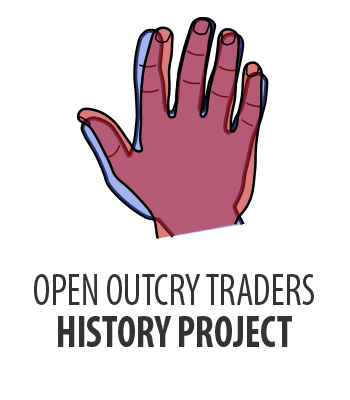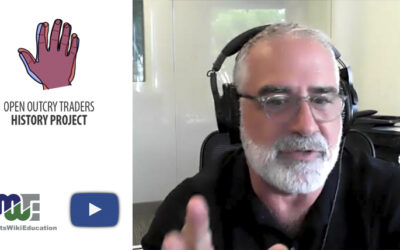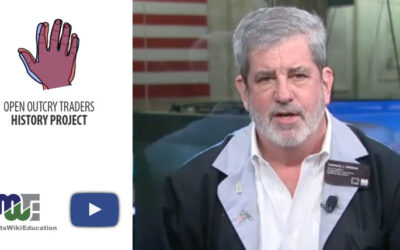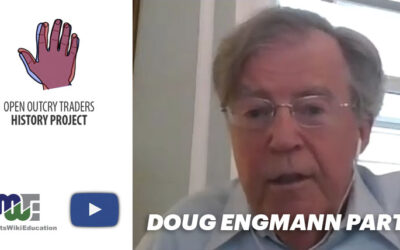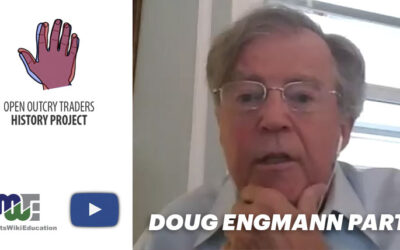WILLIAMS SPOKE TO JOHN LOTHIAN NEWS FOR THE OPEN OUTCRY TRADERS HISTORY PROJECT
Bruce Williams met Blair Hull when both were on a joint CBOT-CBOE committee for a new equity product where different versions would trade at the exchanges. Williams was in the Major Market Index (MMI) trading pit at the Chicago Board of Trade when Hull came into the trading pit during the 1987 stock market crash and started to buy the market. Williams said Hull had never been in the MMI pit before, but Williams knew better than to fade Hull’s buying, Hull being a legendary trader. So Williams bought the market too.
Many smaller traders had been pulled out of the pit by the clearing firms because the risk was so great; the market had started to trade in 10 or 20 point increments, worth $12,500 to $25,000 on every trade. Williams ended up making $250,000 that day, his best trading day ever.
At the time Hull entered the MMI pit, the MMI futures at the CBOT were the only stock market product open. All the other securities and futures markets trading stocks or stock index futures were closed at that time because of the large decline in prices.
When the other markets reopened, they did so at higher levels, reflecting that Hull had turned the MMI prices higher. Williams says Hull is given credit to this day for saving the world, or at least stopping the 1987 stock market crash.
Williams keyed his trading in the MMI pit off of some of the big brokers and what they were doing, including Goldman, CRT and others.
His worst day was while trading in the 10-Year Treasury trading pit back in 1982 when he had just $3,000 in his trading account. Williams was long the market when the Federal Reserve came in and conducted an action that caused the 10-Year Treasury futures to go limit down. Williams did not even know what limit down was at the time, he said.
Williams had lost his $3,000 and more: $19,000 in total. He conferred with Ray Cahnman, whose firm he was clearing through, and was told to go to the office and write down everything he owned. It was not much.
Cahnman worked out a deal in which Williams would be a backup broker and earn commissions filling orders in the 10-Year Treasury futures pit to be able to work off the $19,000 debit. Active markets allowed Williams to earn the amount over two months at $1.80 to $2.00 per contract, freeing him to trade for himself again.
As soon as he had paid back Cahnman, Williams headed to the recently opened MMI trading pit and never looked back. He said he had a much better feel for equities and their fundamentals than interest rates.
Williams moved to the soybean pit on the CBOT trading floor in 1988.
He said he never speculated on errors. He always just liquidated the position and wrote a check for his half of the error.
Opening was an exciting time, when his blood pressure was running high, he said. He always had a pre-existing game plan for the opening, right or wrong.
He said he would often get hit on trades on the close he did not like, which for some traders created problems. Williams once went up to one of the FBI agents who was working undercover in the soybean pit and commented that he was watching him and he was trading well. Williams would often try to help young or new traders, and of course didn’t know the trader/FBI agent was working undercover. The FBI agent, who went by the name Carlson, asked Williams if he wanted to have lunch after the close.
Williams, who had a wife and three kids at home at the time, told the FBI agent no. It was not Williams’ practice to stay around the exchange after the markets closed, which kept him away from a lot of trouble. In this case, it kept Williams from having a secretly-recorded lunch conversation with the FBI agent, and who knows what he would have said, Williams claimed.
Many traders used the curb, trading after the market closed, to even out positions. Eventually rules were changed and trading after the close was allowed in the “modified close.” Several CBOT traders went to jail for trading on the curb after the bell had rung and trading had closed for the day, trying to even positions up or fill orders for customers that should have been filled, Williams said.
Williams would often go to the lunch room above the trading floor when things slowed down during the trading day.
In the mid 1990s, Williams took an office on the 42nd floor of the CBOT that overlooked Lake Michigan, which gave him a place to decompress from trading, he said.
Williams worked with the commercial brokers and keyed off of their activity. As a trader who traded large positions, he would also look at the activity of what he described as the 3 percent club, the elite traders who also traded large volumes.
Williams said he was always trying to be a step ahead of the crowd and would be the first to exit trades because there were only certain traders who could make the size trades he needed.
People looked out for each other and when traders blew out, other traders would give those traders money to get back into the markets. But Williams said that over time, he decided not to give some traders money when he was never paid back and those traders did not display the characteristics Williams thought necessary for success in the markets.
Williams said he was hurting those traders by helping them because it delayed the inevitable for traders who lacked something to make them successful.
Williams said he believes what goes around comes around and that is the way he has lived his life. He always wanted to treat people the way he wanted to be treated. He respected the CBOT mantra of “your word was your bond.” He is grateful for everything he has and received as a member of the CBOT, which is more than he could have ever hoped for from his humble beginnings on the South Side of Chicago.
